MP1482
2A, 18V Synchronous Rectified
Step-Down Converter
Input Under Voltage Lockout
FEATURES
2A Output Current
Wide 4.75V to 18V Operating Input Range
Integrated 130mΩ Power MOSFET Switches
Output Adjustable from 0.923V to 15V
Up to 93% Efficiency
Programmable Soft-Start
Stable with Low ESR Ceramic Output Capacitors
Fixed 340kHz Frequency
Cycle-by-Cycle Over Current Protection
8–Pin SOIC
APPLICATIONS
Distributed Power Systems
Networking Systems
FPGA, DSP, ASIC Power Supplies
Green Electronics/ Appliances
Notebook Computers
All MPS parts are lead-free and adhere to the RoHS directive. For MPS green
status, please visit MPS website under Products, Quality Assurance page.
“MPS” and “The Future of Analog IC Technology” are registered trademarks of
Monolithic Power Systems, Inc.
The Future of Analog IC Technology
DESCRIPTION
The MP1482 is a monolithic synchronous buck
regulator. The device integrates two 130mΩ
MOSFETs, and provides 2A of continuous load
current over a wide input voltage of 4.75V to
18V. Current mode control provides
fast
transient response and cycle-by-cycle current
limit.
An adjustable soft-start prevents inrush current
at turn-on, and in shutdown mode the supply
current drops to 1µA.
This device, available
in an 8-pin SOIC
package, provides a very compact solution with
minimal external components.
TYPICAL APPLICATION
INPUT
2
IN
7
8
EN
SS
GND
4
1
BS
SW
MP1482
FB
COMP
6
3
5
Efficiency vs
Load Current
VOUT = 3.3V
VOUT = 2.5V
0
0.5
1.0
1.5
2.0
LOAD CURRENT (A)
)
%
(
I
Y
C
N
E
C
F
F
E
I
100
95
90
85
80
75
70
65
60
55
50
2.5
1
MP1482 Rev. 1.31
7/9/2012
MPS Proprietary Information. Patent Protected. Unauthorized Photocopy and Duplication Prohibited.
www.MonolithicPower.com
© 2012 MPS. All Rights Reserved.
�
MP1482 – 2A, 18V SYNCHRONOUS RECTIFIED, STEP-DOWN CONVERTER
ORDERING INFORMATION
Top Marking
Package
MP1482DS
SOIC8
Free Air Temperature (TA)
-40C to +85C
Part Number
MP1482DS*
* For Tape & Reel, add suffix –Z (e.g. MP1482DS–Z);
For RoHS Compliant Packaging, add suffix –LF (e.g. MP1482DS–LF–Z)
PACKAGE REFERENCE
TOP VIEW
BS
IN
SW
GND
1
2
3
4
8
7
6
5
SS
EN
COMP
FB
SOIC8
ABSOLUTE MAXIMUM RATINGS (1)
Supply Voltage VIN ........................-0.3V to +20V
Switch Node Voltage VSW ............................ 21V
Boost Voltage VBS ..........VSW – 0.3V to VSW + 6V
All Other Pins..................................-0.3V to +6V
Junction Temperature...............................150°C
Continuous Power Dissipation (TA = +25°C)(2)
SOIC8……………………………………….1.38W
Lead Temperature ....................................260°C
Storage Temperature .............. -65°C to +150°C
Recommended Operating Conditions (3)
Input Voltage VIN ............................4.75V to 18V
Output Voltage VOUT.....................0.923V to 15V
Operating Junct. Temp (TJ)........-40°C to +125°C
Thermal Resistance (4)
SOIC8..................................... 90...... 45... C/W
θJC
θJA
ambient
is
Notes:
1) Exceeding these ratings may damage the device
2) The maximum allowable power dissipation is a function of the
maximum junction temperature TJ(MAX), the junction-to-
ambient thermal resistance θJA, and the ambient temperature
TA. The maximum allowable continuous power dissipation at
any
by
PD(MAX)=(TJ(MAX)-TA)/ θJA. Exceeding
the maximum
allowable power dissipation will cause excessive die
temperature, and the regulator will go into thermal shutdown.
Internal thermal shutdown circuitry protects the device from
permanent damage..
temperature
calculated
3) The device is not guaranteed to function outside of its
operating conditions.
4) Measured on JESD51-7, 4-layer board.
MP1482 Rev. 1.31
7/9/2012
MPS Proprietary Information. Patent Protected. Unauthorized Photocopy and Duplication Prohibited.
www.MonolithicPower.com
© 2012 MPS. All Rights Reserved.
2
�
MP1482 – 2A, 18V SYNCHRONOUS RECTIFIED, STEP-DOWN CONVERTER
Symbol Condition
VEN = 0V
VEN = 2.0V; VFB = 1.0V
4.75V VIN 18V
IC = 10μA
VEN = 0V, VSW = 0V
Minimum Duty Cycle
From Drain to Source
Fosc1
Fosc2 VFB = 0V
DMAX VFB = 1.0V
VFB
AEA
GEA
RDS(ON)1
RDS(ON)2
ELECTRICAL CHARACTERISTICS
VIN = 12V, TA = +25°C, unless otherwise noted.
Parameter
Shutdown Supply Current
Supply Current
Feedback Voltage
Feedback Overvoltage Threshold
Error Amplifier Voltage Gain (5)
Error Amplifier Transconductance
High-Side Switch On Resistance (5)
Low-Side Switch On Resistance (5)
High-Side Switch Leakage Current
Upper Switch Current Limit
Lower Switch Current Limit
COMP to Current Sense
Transconductance
Oscillation Frequency
Short Circuit Oscillation Frequency
Maximum Duty Cycle
Minimum On Time (5)
EN Shutdown Threshold Voltage
EN Shutdown Threshold Voltage
Hysteresis
EN Lockout Threshold Voltage
EN Lockout Hysterisis
Input Under Voltage Lockout
Threshold
Input Under Voltage Lockout
Threshold Hysteresis
Soft-Start Current
Soft-Start Period
Thermal Shutdown (5)
Note:
5) Guaranteed by design, not tested.
GCS
VEN Rising
VIN Rising
VSS = 0V
CSS = 0.1μF
Min
0.900
2.4
305
1.1
2.2
3.80
Typ
1
1.3
0.923
1.1
400
800
130
130
3.4
1.1
3.5
340
100
90
220
1.5
210
2.5
210
4.10
210
6
15
160
Max
3.0
1.5
0.946
10
375
2.0
2.7
4.40
Units
μA
mA
V
V
V/V
μA/V
mΩ
mΩ
μA
A
A
A/V
kHz
kHz
%
ns
V
mV
V
mV
V
mV
μA
ms
°C
MP1482 Rev. 1.31
7/9/2012
MPS Proprietary Information. Patent Protected. Unauthorized Photocopy and Duplication Prohibited.
www.MonolithicPower.com
© 2012 MPS. All Rights Reserved.
3
�
MP1482 – 2A, 18V SYNCHRONOUS RECTIFIED, STEP-DOWN CONVERTER
PIN FUNCTIONS
SOIC8
Pin # Name Description
1
2
3
4
5
6
7
8
BS High-Side Gate Drive Boost Input. BS supplies the drive for the high-side N-Channel MOSFET
switch. Connect a 0.01μF or greater capacitor from SW to BS to power the high side switch.
Power Input. IN supplies the power to the IC, as well as the step-down converter switches.
Drive IN with a 4.75V to 18V power source. Bypass IN to GND with a suitably large capacitor to
eliminate noise on the input to the IC. See Input Capacitor.
Power Switching Output. SW is the switching node that supplies power to the output. Connect
the output LC filter from SW to the output load. Note that a capacitor is required from SW to BS
to power the high-side switch.
IN
SW
GND Ground.
FB
COMP
Feedback Input. FB senses the output voltage to regulate that voltage. Drive FB with a resistive
voltage divider from the output voltage. The feedback threshold is 0.923V. See Setting the
Output Voltage.
Compensation Node. COMP is used to compensate the regulation control loop. Connect a
series RC network from COMP to GND to compensate the regulation control loop. In some
cases, an additional capacitor from COMP to GND is required. See Compensation
Components.
EN Enable Input. EN is a digital input that turns the regulator on or off. Drive EN high to turn on the
regulator, drive it low to turn it off. Pull up with 100kΩ resistor for automatic startup.
Soft-Start Control Input. SS controls the soft start period. Connect a capacitor from SS to GND
to set the soft-start period. A 0.1μF capacitor sets the soft-start period to 15ms. To disable the
soft-start feature, leave SS unconnected.
SS
MP1482 Rev. 1.31
7/9/2012
MPS Proprietary Information. Patent Protected. Unauthorized Photocopy and Duplication Prohibited.
www.MonolithicPower.com
© 2012 MPS. All Rights Reserved.
4
�
MP1482 – 2A, 18V SYNCHRONOUS RECTIFIED, STEP-DOWN CONVERTER
TYPICAL PERFORMANCE CHARACTERISTICS
VIN = 12V, VO = 3.3V, L = 10µH, C1 = 10µF, C2 = 22µF, TA = +25°C, unless otherwise noted.
Steady State Test
VIN = 12V, VOUT = 3.3V
IOUT = 0A, IIN= 8.2mA
Startup through Enable
VIN = 12V, VOUT = 3.3V
IOUT = 1A (Resistance Load)
Shutdown through Enable
VIN = 12V, VOUT = 3.3V
IOUT = 1A (Resistance Load)
VIN
20mV/div.
VOUT
20mV/div.
IL
1A/div.
VSW
10V/div.
VIN, AC
200mV/div.
VO, AC
20mV/div.
IL
1A/div.
VSW
10V/div.
VOUT
2V/div.
IL
2A/div.
VEN
5V/div.
VOUT
1V/div.
IL
1A/div.
VSW
10V/div.
VEN
5V/div.
VOUT
2V/div.
IL
1A/div.
VSW
10V/div.
Heavy Load Operation
2A Load
Medium Load Operation
1A Load
Light Load Operation
No Load
VIN, AC
200mV/div.
VO, AC
20mV/div.
IL
1A/div.
VSW
10V/div.
VIN, AC
20mV/div.
VO, AC
20mV/div.
IL
1A/div.
VSW
10V/div.
Short Circuit
Protection
Short Circuit
Recovery
Load Transient
VOUT
2V/div.
IL
2A/div.
VOUT
200mV/div.
IL
1A/div.
ILOAD
1A/div.
MP1482 Rev. 1.31
7/9/2012
MPS Proprietary Information. Patent Protected. Unauthorized Photocopy and Duplication Prohibited.
www.MonolithicPower.com
© 2012 MPS. All Rights Reserved.
5
�
MP1482 – 2A, 18V SYNCHRONOUS RECTIFIED, STEP-DOWN CONVERTER
the
to step-down
converter uses
internal N-Channel
The
MOSFET switches
input
voltage to the regulated output voltage. Since
the high side MOSFET requires a gate voltage
greater than the input voltage, a boost capacitor
connected between SW and BS is needed to
drive the high side gate. The boost capacitor is
charged from the internal 5V rail when SW is low.
When the MP1482 FB pin exceeds 20% of the
nominal regulation voltage of 0.923V, the over
voltage comparator is tripped and the COMP
pin and the SS pin are discharged to GND,
forcing the high-side switch off.
is a synchronous
OPERATION
FUNCTIONAL DESCRIPTION
The MP1482
rectified,
current-mode, step-down regulator. It regulates
input voltages from 4.75V to 18V down to an
output voltage as low as 0.923V, and supplies
up to 2A of load current.
The MP1482 uses current-mode control to
regulate the output voltage. The output voltage
is measured at FB through a resistive voltage
divider and amplified
internal
transconductance error amplifier. The voltage at
the COMP pin is compared to the switch current
measured
the output
voltage.
to control
internally
through
the
FB
SS
COMP
EN
+
--
+
--
--
+
+
--
+
+
--
1.1V
0.3V
0.923V
2.5V
1.5V
OVP
OSCILLATOR
340KHz
RAMP
CLK
ERROR
AMPLIFIER
EN OK
LOCKOUT
COMPARATOR
SHUTDOWN
COMPARATOR
CURRENT
SENSE
AMPLIFIER
+
--
S
R
Q
Q
CURRENT
COMPARATOR
1.2V
IN
BS
SW
GND
+
--
5V
OVP
IN < 4.1V
IN
INTERNAL
REGULATORS
Figure 1—Functional Block Diagram
MP1482 Rev. 1.31
7/9/2012
MPS Proprietary Information. Patent Protected. Unauthorized Photocopy and Duplication Prohibited.
www.MonolithicPower.com
© 2012 MPS. All Rights Reserved.
6
�
APPLICATIONS INFORMATION
COMPONENT SELECTION
Setting the Output Voltage
The output voltage is set using a resistive
voltage divider from the output voltage to FB pin.
The voltage divider divides the output voltage
down to the feedback voltage by the ratio:
V
FB
V
OUT
2R
2R1R
Where VFB is the feedback voltage and VOUT is
the output voltage.
Thus the output voltage is:
VOUT
.0
923
2R1R
2R
R2 can be as high as 100kΩ, but a typical value
is 10kΩ. Using the typical value for R2, R1 is
determined by:
1R
83.10
V(
OUT
.0
923
)
(kΩ)
For example, for a 3.3V output voltage, R2 is
10kΩ, and R1 is 26.1kΩ.
Inductor
The inductor is required to supply constant
current to the output load while being driven by
the switched input voltage. A larger value
inductor will result in less ripple current that will
result in lower output ripple voltage. However,
the larger value inductor will have a larger
physical size, higher series resistance, and/or
lower saturation current. A good rule
for
determining the inductance to use is to allow
the peak-to-peak ripple current in the inductor
to be approximately 30% of the maximum
switch current limit. Also, make sure that the
peak inductor current is below the maximum
switch current limit. The inductance value can
be calculated by:
V
OUT
I
V
OUT
V
IN
1
L
S
f
L
Where VOUT is the output voltage, VIN is the
input voltage, fS is the switching frequency, and
ΔIL is the peak-to-peak inductor ripple current.
MP1482 – 2A, 18V SYNCHRONOUS RECTIFIED, STEP-DOWN CONVERTER
Choose an inductor that will not saturate under
the maximum inductor peak current. The peak
inductor current can be calculated by:
S
L
1
I
LP
I
LOAD
V
OUT
V
IN
V
OUT
f2
Where ILOAD is the load current.
The choice of which style inductor to use mainly
depends on the price vs. size requirements and
any EMI requirements.
Optional Schottky Diode
During the transition between high-side switch
and low-side switch, the body diode of the low-
side power MOSFET conducts the inductor
current. The forward voltage of this body diode
is high. An optional Schottky diode may be
paralleled between the SW pin and GND pin to
improve overall efficiency. Table 1 lists example
Schottky diodes and their Manufacturers.
Table 1—Diode Selection Guide
Part Number Voltage/Current
B130
SK13
Rating
30V, 1A
30V, 1A
MBRS130
30V, 1A
Vendor
Diodes, Inc.
Diodes, Inc.
International
Rectifier
the DC
Input Capacitor
The input current to the step-down converter is
discontinuous, therefore a capacitor is required
to supply the AC current to the step-down
converter while maintaining
input
voltage. Use low ESR capacitors for the best
performance. Ceramic capacitors are preferred,
but tantalum or low-ESR electrolytic capacitors
may also suffice. Choose X5R or X7R
dielectrics when using ceramic capacitors.
Since the input capacitor (C1) absorbs the input
switching current it requires an adequate ripple
current rating. The RMS current in the input
capacitor can be estimated by:
I
1C
I
LOAD
V
OUT
V
IN
V1
OUT
V
IN
MP1482 Rev. 1.31
7/9/2012
MPS Proprietary Information. Patent Protected. Unauthorized Photocopy and Duplication Prohibited.
www.MonolithicPower.com
© 2012 MPS. All Rights Reserved.
7
�
The worst-case condition occurs at VIN = 2VOUT,
where IC1 = ILOAD/2. For simplification, choose
the input capacitor whose RMS current rating
greater than half of the maximum load current.
The input capacitor can be electrolytic, tantalum
or ceramic. When using electrolytic or tantalum
capacitors, a small, high quality ceramic
capacitor, i.e. 0.1μF, should be placed as close
to the IC as possible. When using ceramic
capacitors, make sure that they have enough
capacitance to provide sufficient charge to
prevent excessive voltage ripple at input. The
input voltage ripple for low ESR capacitors can
be estimated by:
MP1482 – 2A, 18V SYNCHRONOUS RECTIFIED, STEP-DOWN CONVERTER
The characteristics of the output capacitor also
affect the stability of the regulation system. The
MP1482 can be optimized for a wide range of
capacitance and ESR values.
Compensation Components
MP1482 employs current mode control for easy
compensation and fast transient response. The
system stability and transient response are
controlled through the COMP pin. COMP pin is
the output of the internal transconductance
error amplifier. A series capacitor-resistor
combination sets a pole-zero combination to
control the characteristics of the control system.
The DC gain of the voltage feedback loop is
given by:
V
IN
I
LOAD
f1C
S
V
OUT
V
IN
V1
OUT
V
IN
Where C1 is the input capacitance value.
Output Capacitor
The output capacitor is required to maintain the
DC output voltage. Ceramic, tantalum, or low
ESR electrolytic capacitors are recommended.
Low ESR capacitors are preferred to keep the
output voltage ripple low. The output voltage
ripple can be estimated by:
1
OUT
R
ESR
V
V
f
S
2C
1
f8
S
OUT
L
V
OUT
V
IN
the case of ceramic capacitors,
Where C2 is the output capacitance value and
RESR is the equivalent series resistance (ESR)
value of the output capacitor.
the
In
impedance at
is
dominated by the capacitance. The output
voltage
the
capacitance. For simplification,
the output
voltage ripple can be estimated by:
V
OUT
V
IN
is mainly caused by
the switching
V
OUT
2
frequency
ripple
2CL
1
ΔV
OUT
f8
S
In the case of tantalum or electrolytic capacitors,
the ESR dominates the impedance at the
switching
the
output ripple can be approximated to:
frequency. For simplification,
ΔV
OUT
V
OUT
L
f
S
1
V
OUT
V
IN
R
ESR
A
VDC
R
LOAD
G
CS
A
EA
V
FB
V
OUT
Where AVEA is the error amplifier voltage gain;
GCS is the current sense transconductance and
RLOAD is the load resistor value.
The system has two poles of importance. One
is due to the compensation capacitor (C3) and
the output resistor of the error amplifier, and the
other is due to the output capacitor and the load
resistor. These poles are located at:
f
1P
G
EA
A3C2
VEA
f
2P
1
R2C
2
LOAD
Where GEA is the error amplifier transconductance.
The system has one zero of importance, due to the
compensation capacitor (C3) and the compensation
resistor (R3). This zero is located at:
f 1Z
1
3R3C2
The system may have another zero of
importance, if the output capacitor has a large
capacitance and/or a high ESR value. The zero,
due to the ESR and capacitance of the output
capacitor, is located at:
f
ESR
1
R2C
2
ESR
MP1482 Rev. 1.31
7/9/2012
MPS Proprietary Information. Patent Protected. Unauthorized Photocopy and Duplication Prohibited.
www.MonolithicPower.com
© 2012 MPS. All Rights Reserved.
8
�
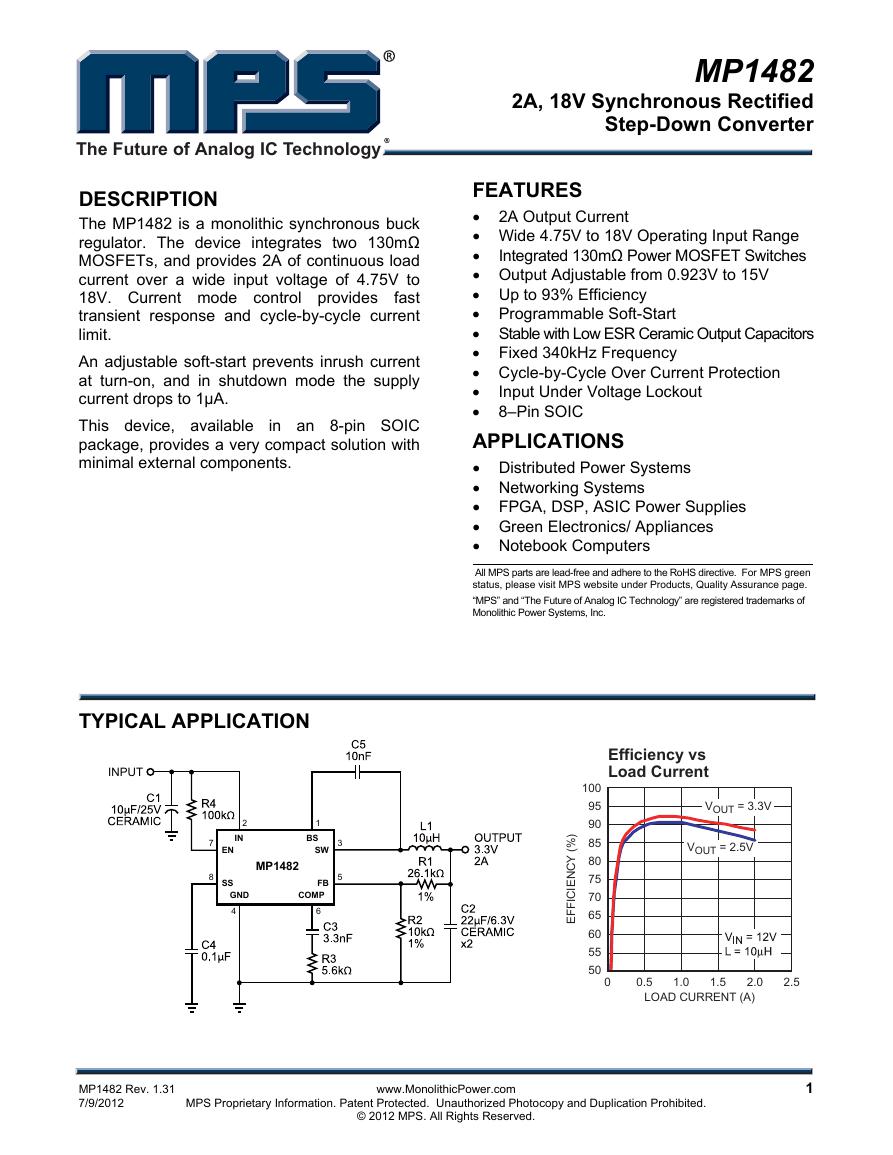
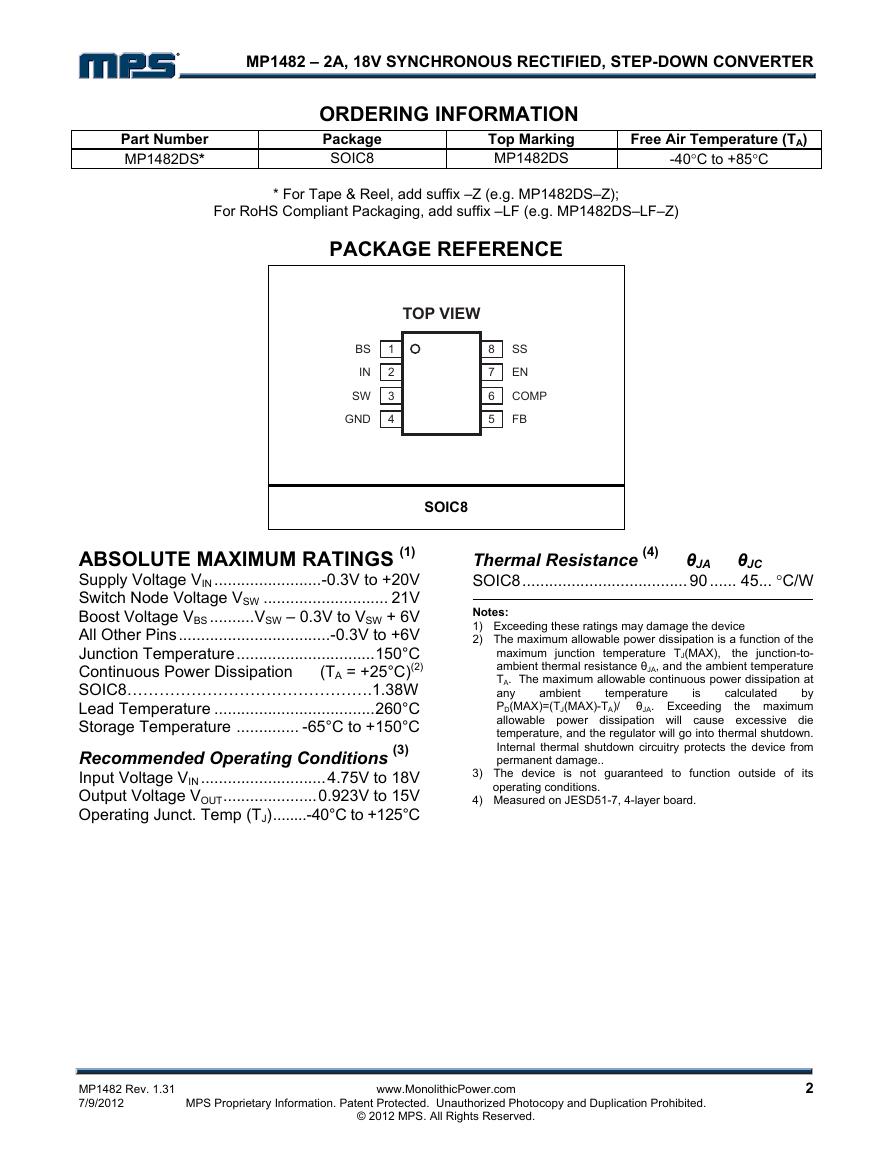
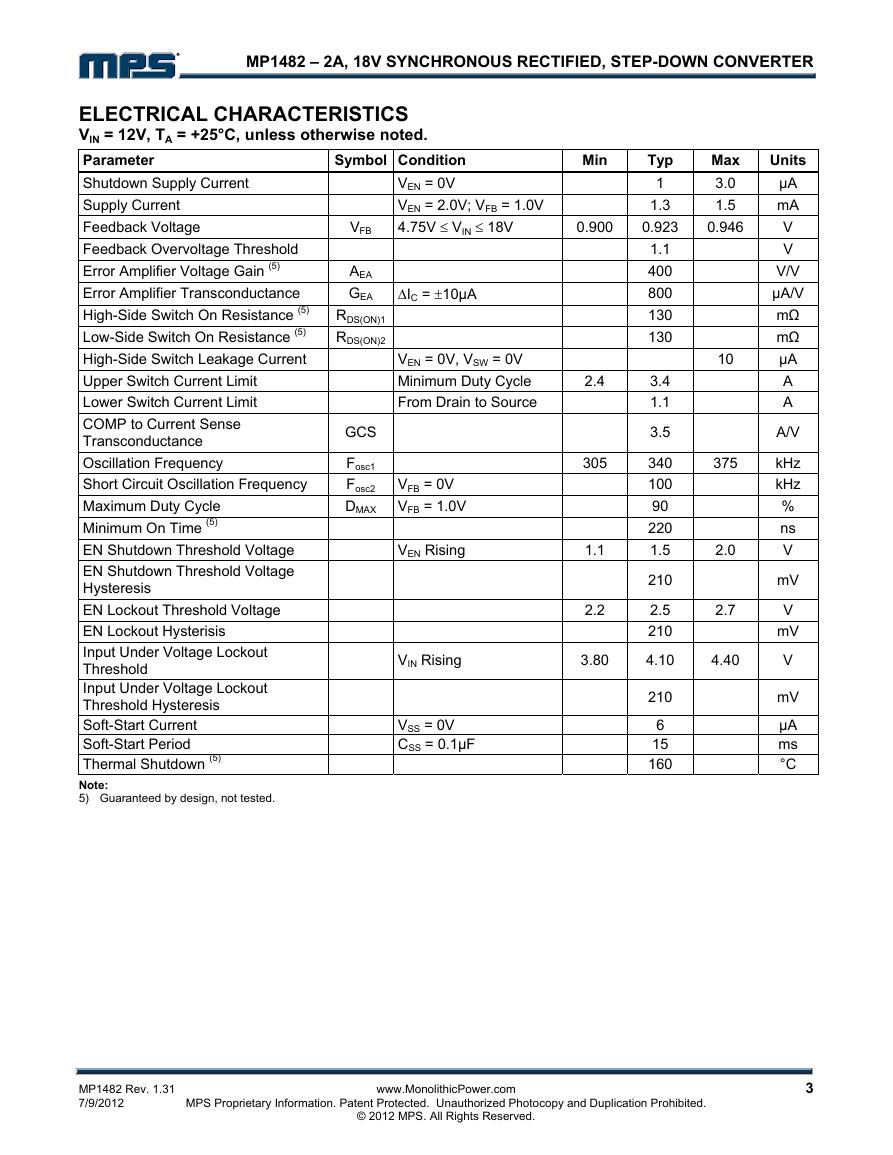
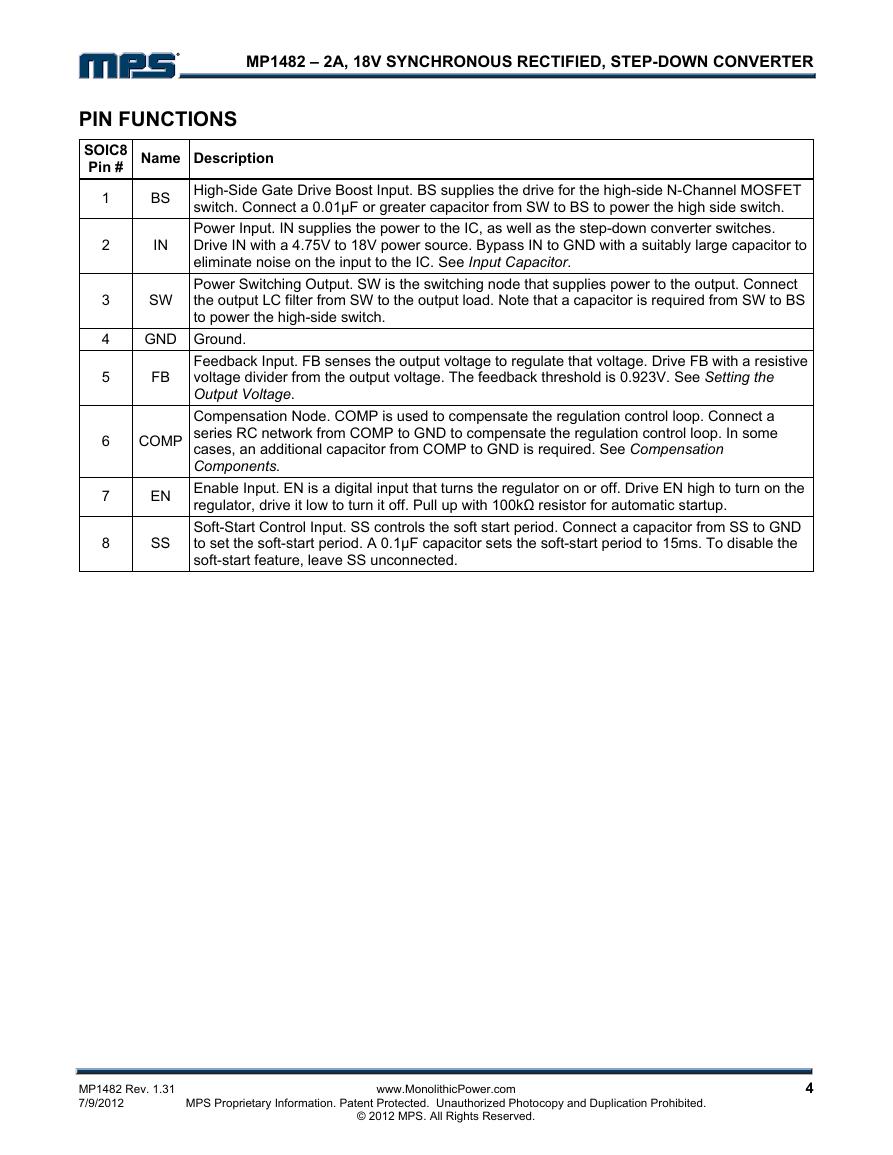
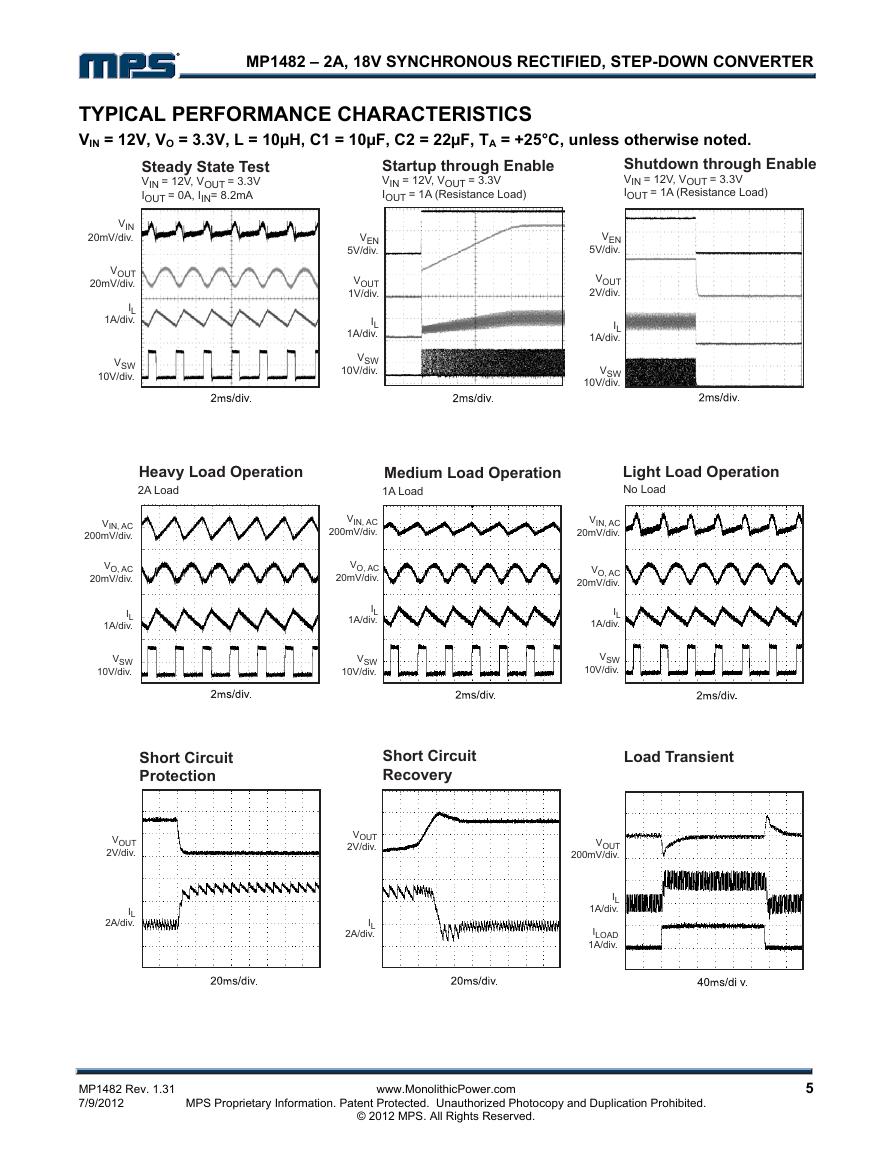
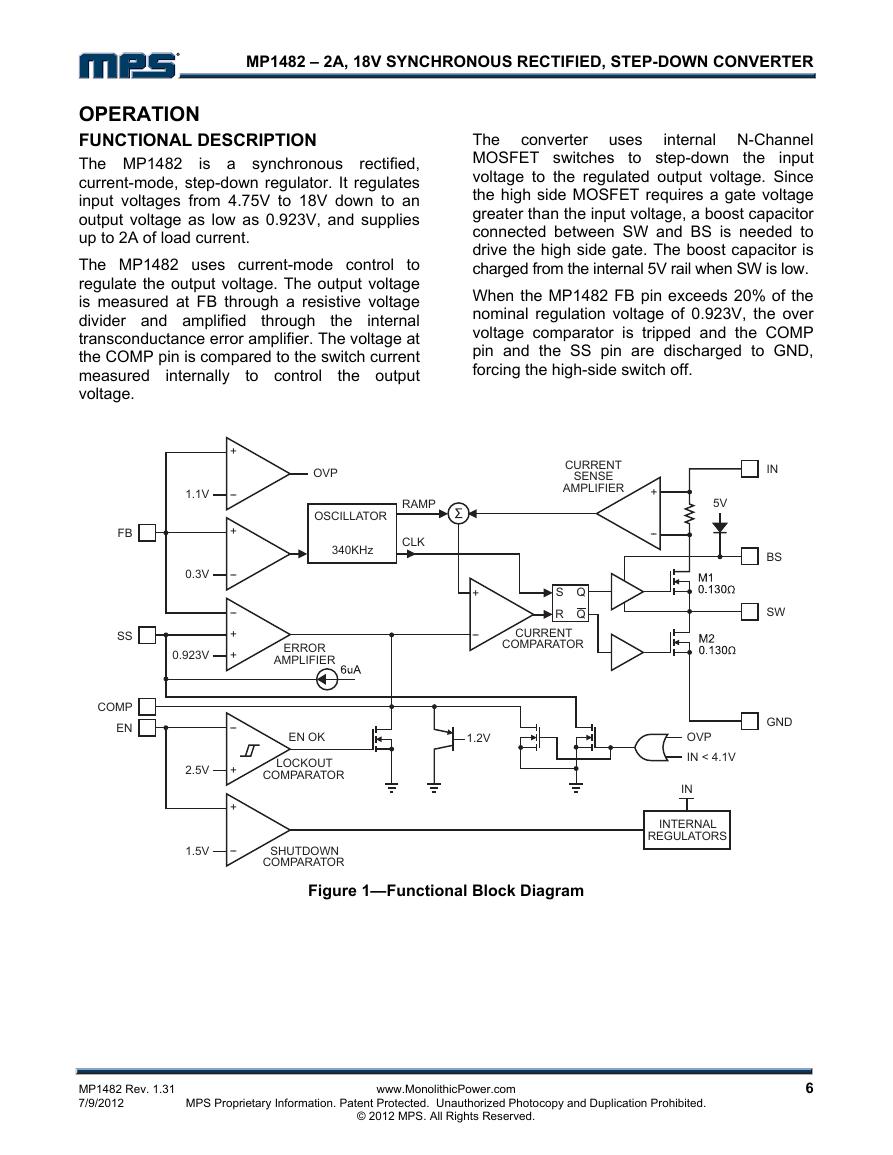
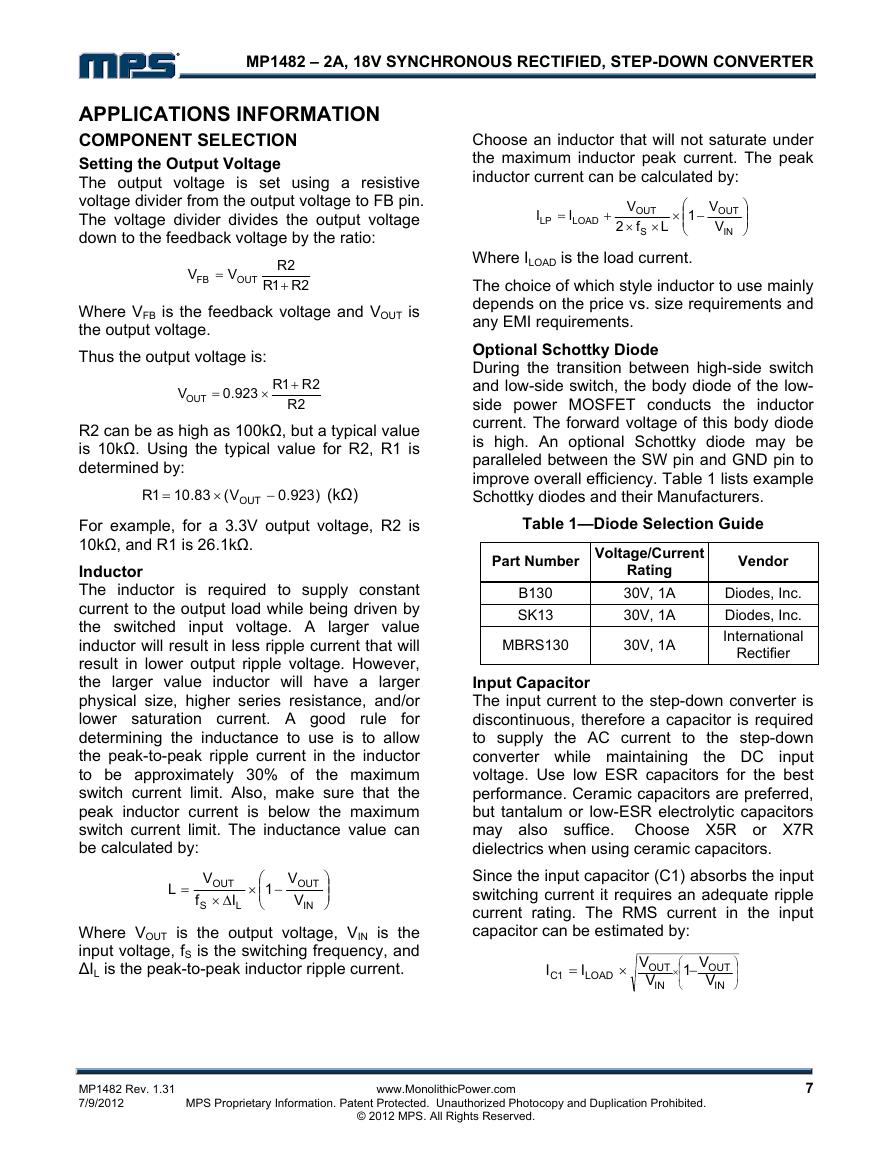









 V2版本原理图(Capacitive-Fingerprint-Reader-Schematic_V2).pdf
V2版本原理图(Capacitive-Fingerprint-Reader-Schematic_V2).pdf 摄像头工作原理.doc
摄像头工作原理.doc VL53L0X简要说明(En.FLVL53L00216).pdf
VL53L0X简要说明(En.FLVL53L00216).pdf 原理图(DVK720-Schematic).pdf
原理图(DVK720-Schematic).pdf 原理图(Pico-Clock-Green-Schdoc).pdf
原理图(Pico-Clock-Green-Schdoc).pdf 原理图(RS485-CAN-HAT-B-schematic).pdf
原理图(RS485-CAN-HAT-B-schematic).pdf File:SIM7500_SIM7600_SIM7800 Series_SSL_Application Note_V2.00.pdf
File:SIM7500_SIM7600_SIM7800 Series_SSL_Application Note_V2.00.pdf ADS1263(Ads1262).pdf
ADS1263(Ads1262).pdf 原理图(Open429Z-D-Schematic).pdf
原理图(Open429Z-D-Schematic).pdf 用户手册(Capacitive_Fingerprint_Reader_User_Manual_CN).pdf
用户手册(Capacitive_Fingerprint_Reader_User_Manual_CN).pdf CY7C68013A(英文版)(CY7C68013A).pdf
CY7C68013A(英文版)(CY7C68013A).pdf TechnicalReference_Dem.pdf
TechnicalReference_Dem.pdf